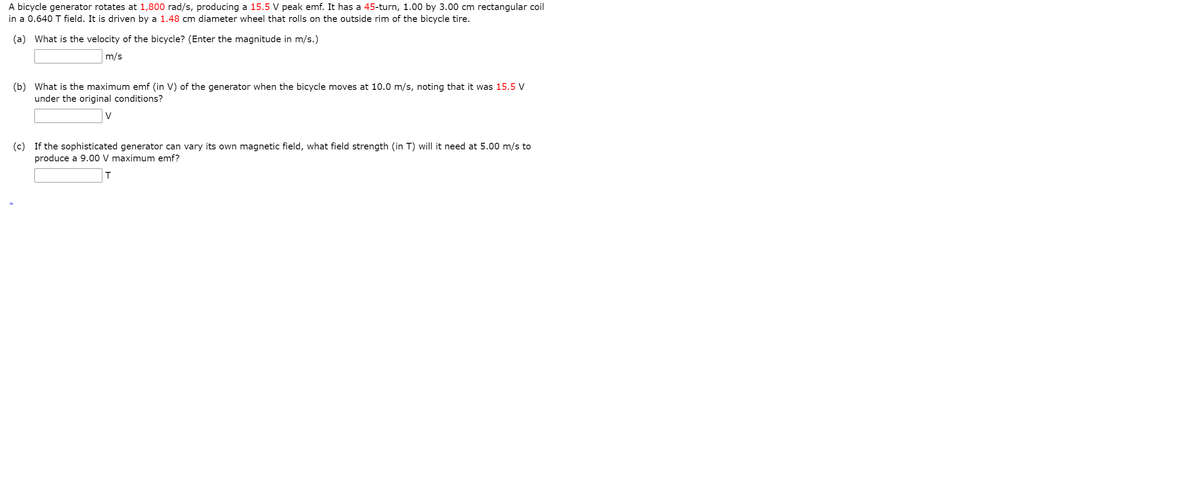A bicycle generator rotates at 1,800 rad/s, producing a 15.5 V peak emf. It has a 45-turn, 1.00 by 3.00 cm rectangular coil in a 0.640 T field. It is driven by a 1.48 cm diameter wheel that rolls on the outside rim of the bicycle tire. (a) What is the velocity of the bicycle? (Enter the magnitude in m/s.) |m/s (b) What is the maximum emf (in V) of the generator when the bicycle moves at 10.0 m/s, noting that it was 15.5 V under the original conditions? (e) If the sophisticated generator can vary its own magnetic field, what field strength (in T) will it need at 5.00 m/s to produce a 9.00 V maximum emf?
A bicycle generator rotates at 1,800 rad/s, producing a 15.5 V peak emf. It has a 45-turn, 1.00 by 3.00 cm rectangular coil in a 0.640 T field. It is driven by a 1.48 cm diameter wheel that rolls on the outside rim of the bicycle tire. (a) What is the velocity of the bicycle? (Enter the magnitude in m/s.) |m/s (b) What is the maximum emf (in V) of the generator when the bicycle moves at 10.0 m/s, noting that it was 15.5 V under the original conditions? (e) If the sophisticated generator can vary its own magnetic field, what field strength (in T) will it need at 5.00 m/s to produce a 9.00 V maximum emf?
Physics for Scientists and Engineers: Foundations and Connections
1st Edition
ISBN:9781133939146
Author:Katz, Debora M.
Publisher:Katz, Debora M.
Chapter32: Faraday’s Law Of Induction
Section: Chapter Questions
Problem 35PQ
Related questions
Question
100%

Transcribed Image Text:A bicycle generator rotates at 1,800 rad/s, producing a 15.5 V peak emf. It has a 45-turn, 1.00 by 3.00 cm rectangular coil
in a 0.640 T field. It is driven by a 1.48 cm diameter wheel that rolls on the outside rim of the bicycle tire.
(a) What is the velocity of the bicycle? (Enter the magnitude in m/s.)
m/s
(b) What is the maximum emf (in V) of the generator when the bicycle moves at 10.0 m/s, noting that it was 15.5 V
under the original conditions?
V
(c) If the sophisticated generator can vary its own magnetic field, what field strength (in T) will it need at 5.00 m/s to
produce a 9.00 V maximum emf?
Expert Solution
This question has been solved!
Explore an expertly crafted, step-by-step solution for a thorough understanding of key concepts.
This is a popular solution!
Trending now
This is a popular solution!
Step by step
Solved in 2 steps with 2 images

Knowledge Booster
Learn more about
Need a deep-dive on the concept behind this application? Look no further. Learn more about this topic, physics and related others by exploring similar questions and additional content below.Recommended textbooks for you

Physics for Scientists and Engineers: Foundations…
Physics
ISBN:
9781133939146
Author:
Katz, Debora M.
Publisher:
Cengage Learning

Physics for Scientists and Engineers with Modern …
Physics
ISBN:
9781337553292
Author:
Raymond A. Serway, John W. Jewett
Publisher:
Cengage Learning

Physics for Scientists and Engineers
Physics
ISBN:
9781337553278
Author:
Raymond A. Serway, John W. Jewett
Publisher:
Cengage Learning

Physics for Scientists and Engineers: Foundations…
Physics
ISBN:
9781133939146
Author:
Katz, Debora M.
Publisher:
Cengage Learning

Physics for Scientists and Engineers with Modern …
Physics
ISBN:
9781337553292
Author:
Raymond A. Serway, John W. Jewett
Publisher:
Cengage Learning

Physics for Scientists and Engineers
Physics
ISBN:
9781337553278
Author:
Raymond A. Serway, John W. Jewett
Publisher:
Cengage Learning

College Physics
Physics
ISBN:
9781285737027
Author:
Raymond A. Serway, Chris Vuille
Publisher:
Cengage Learning

Principles of Physics: A Calculus-Based Text
Physics
ISBN:
9781133104261
Author:
Raymond A. Serway, John W. Jewett
Publisher:
Cengage Learning
